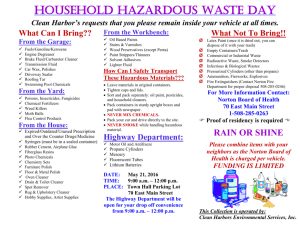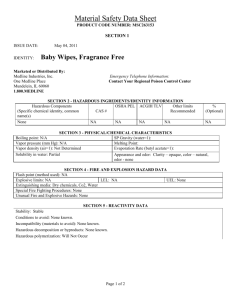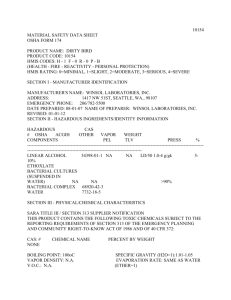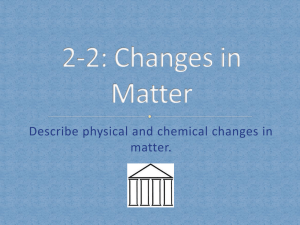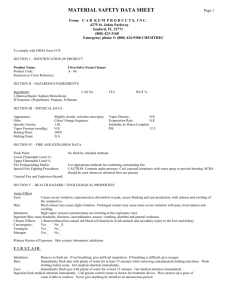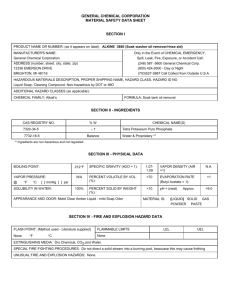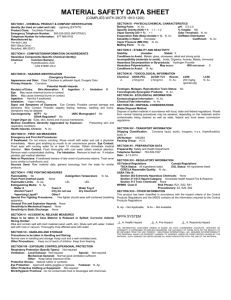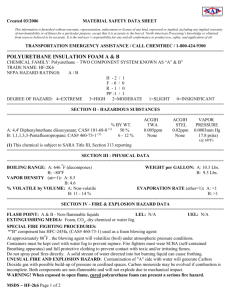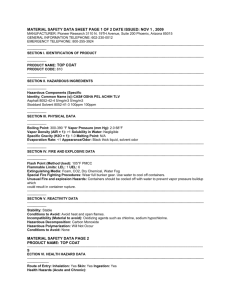Material Safety Data Sheet (Propane)
advertisement
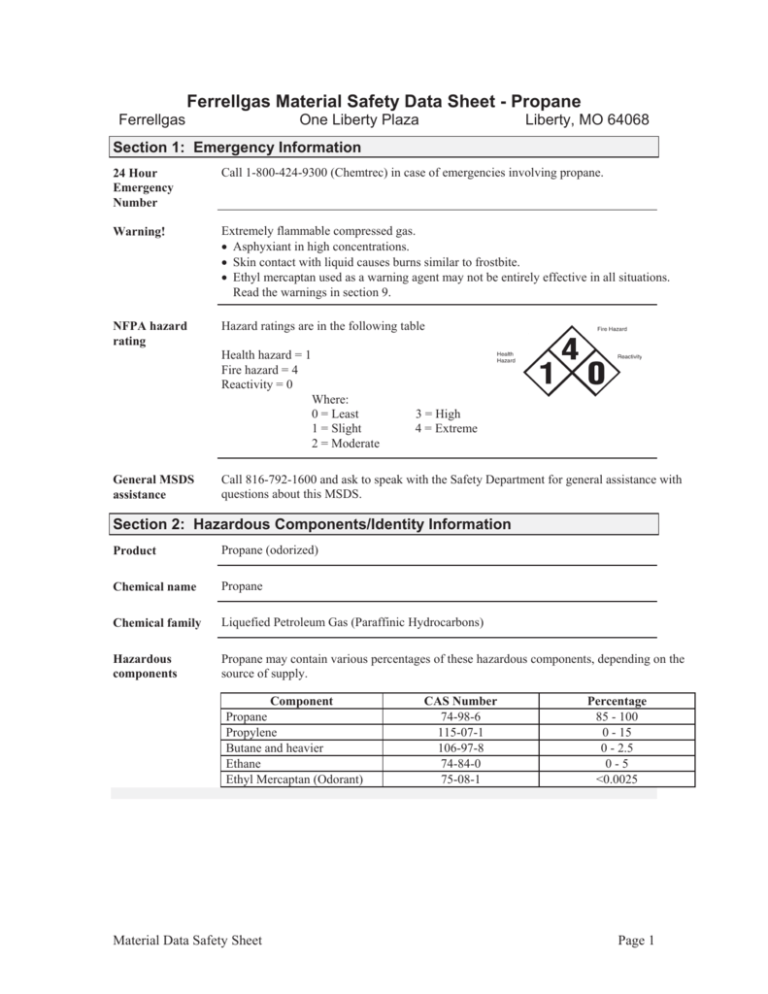
Ferrellgas Material Safety Data Sheet - Propane Ferrellgas One Liberty Plaza Liberty, MO 64068 Section 1: Emergency Information 24 Hour Emergency Number Call 1-800-424-9300 (Chemtrec) in case of emergencies involving propane. Warning! Extremely flammable compressed gas. x Asphyxiant in high concentrations. x Skin contact with liquid causes burns similar to frostbite. x Ethyl mercaptan used as a warning agent may not be entirely effective in all situations. Read the warnings in section 9. NFPA hazard rating Hazard ratings are in the following table Health hazard = 1 Fire hazard = 4 Reactivity = 0 Where: 0 = Least 1 = Slight 2 = Moderate General MSDS assistance 3 = High 4 = Extreme Call 816-792-1600 and ask to speak with the Safety Department for general assistance with questions about this MSDS. Section 2: Hazardous Components/Identity Information Product Propane (odorized) Chemical name Propane Chemical family Liquefied Petroleum Gas (Paraffinic Hydrocarbons) Hazardous components Propane may contain various percentages of these hazardous components, depending on the source of supply. Component Propane Propylene Butane and heavier Ethane Ethyl Mercaptan (Odorant) Material Data Safety Sheet CAS Number 74-98-6 115-07-1 106-97-8 74-84-0 75-08-1 Percentage 85 - 100 0 - 15 0 - 2.5 0-5 <0.0025 Page 1 Section 3: Health Information Purpose The health effects are consistent with requirements of the OSHA Hazard Communication Standard (29 CFR 1910.1200). Eye contact Direct contact with liquid propane can result in eye burns. Skin contact Direct contact with liquid propane can result in skin burns (frostbite). Inhalation This product is classified as a simple asphyxiant. High vapor concentrations may produce a reversible central nervous system depression (anesthesia). Higher concentrations may produce asphyxiation. Ingestion Ingestion is not likely. Signs and symptoms Eye or skin burns (frostbite) as noted previously. Early to moderate central nervous system depression may be evidenced by giddiness, headache, dizziness and nausea. In extreme cases, unconsciousness may occur. Asphyxiation may be noted by a sudden loss of consciousness. Death may quickly follow. Aggravated medical conditions Caution is recommended for personnel with pre-existing central nervous system or chronic respiratory diseases. Acute toxicity data Acute toxicity data is not applicable to this product. Carcinogenicity This product is not classified as a carcinogen. Occupational exposure limits Use this table to determine the allowable exposure limits for personnel. OSHA PEL/TWA Propane: 1,000 PPM Butane: 800 PPM ACGIH PEL/Ceiling Not established TLV/TWA Butane: 800 PPM TLV/STEL Not established Cardiac effects While there is no evidence that exposure to industrially acceptable levels of hydrocarbons have produced cardiac effects in humans, animal studies have shown that inhalation of high vapor levels of the components of this product have produced cardiac sensitization. Such sensitization may cause fatal changes in heart rhythms. This latter effect was shown to be enhanced by hypoxia or the injection of adrenaline-like agents. Effects of propylene Laboratory animals exposed to high levels of propylene for prolonged periods of time showed evidence of effects in the liver, kidneys, and nasal cavity. Page 2 Material Safety Data Sheet Section 4: Emergency and First Aid Procedures Purpose Follow these procedures in case of personal injuries resulting from use of this product. Eye contact with liquid Flush eyes with water. Get medical attention. Skin contact with liquid Flush with water. If frostbite or burn occurs, get medical attention. Inhalation Remove victim to fresh air and provide oxygen if breathing is difficult. Seek immediate medical attention if victim is not breathing. Give artificial respiration. Ingestion Not applicable to this product. Section 5: Physical Data Physical properties Refer to this table for the physical properties of this product. Property Appearance and odor Boiling point Evaporation rate (Butyl Acetate = 1) Flash point Liquid to vapor expansion ratio Molecular weight Solubility in water Specific gravity (liquid) Specific gravity (vapor) Vapor pressure (maximum) Value Colorless gas, liquid under pressure. Mercaptan “rotten cabbage” odor -44 degrees F. <1 (diffuses readily) -156 degrees F. 1:270 44.096 Slight 0.500 - 0.510 (Water = 1) 1.52 (Air = 1) 208 PSIG @ 100 degrees F. Section 6: Fire and Explosion Hazards Flammability limits Flammability limits by volume in air. x Lower 2.15 percent x Upper 9.6 percent Ignition temperature Auto Ignition temperature is 940 degrees, F. Extinguishing media Allow product to burn if source cannot be shut off safely. x Class B-C or A-B-C dry chemical or halon extinguishers can be used on small fires. x Apply water from a safe distance to cool containers, surrounding equipment, and structures. 4 Continued on next page Material Data Safety Sheet Page 3 Section 6: Fire and Explosion Hazards, Continued Special fire fighting procedures and precautions Extremely flammable. Containers may explode if not sufficiently cooled with water spray. Evacuate surrounding area of unprotected personnel and isolate. Do not enter confined fire space without full bunker gear (helmet with face shield, bunker coats, gloves, and rubber boots) and a positive pressure NIOSH approved self-contained breathing apparatus. Section 7: Reactivity Stability and hazardous polymerization This product is stable. Hazardous polymerization will not occur. Conditions and materials to avoid Avoid heat, sparks, flame and contact with strong oxidizing agents. Avoid buildups of static electricity. x Prevent vapor accumulation. Hazardous decomposition products Carbon monoxide and unidentified organic products may be formed during combustion. Section 8: Employee Protection Respiratory protection Use a NIOSH approved respirator as required when airborn exposure limits are exceeded. x In accord with 29 CFR 1910.134, use either an atmosphere supplying respirator or an air purifying respirator for organic vapors. Protective clothing Avoid liquid contact with eyes or skin. x Wear safety glasses or goggles as appropriate. x Wear protective clothing as appropriate. Additional protective measures Use explosion-proof ventilation as required to control vapor concentrations. Section 9: Precautions For Safe Handling and Use Release, spill or leak procedures Warning! Extremely flammable. x Eliminate sources of ignition. x Isolate hazard area and deny entry to unnecessary or unprotected personnel. x Stay upwind and keep out of low areas. x Notify local fire department. x Disperse vapor clouds with water spray. x Shut off source of leak only if it can be done safely. Continued on next page Page 4 Material Safety Data Sheet Section 9: Precautions For Safe Handling and Use, Continued Training Train all personnel involved in handling propane in proper handling and operating procedures. x Document all training. Handling and storing Handle and store propane in accordance with NFPA 58 and local fire codes. x Keep containers away from heat sources or temperatures exceeding 130 degrees F. x Do not drop or roll any container. x Store and transport containers with relief valves in vapor space. x Keep all container valves closed when not in use. x Keep protective caps (if applicable) on containers when not in use. DOT cylinders Take these precautions when using DOT cylinders. x Periodically inspect and requalify DOT cylinders in accordance with DOT and NFPA 58 codes and Compressed Gas Association Pamphlets C-6 and C-6a. x Store and use cylinders with valves off and the relief valves in the container vapor space. x Shut all valves and follow recommended procedures before exchanging cylinders. Special precautions Containers, even those that have been emptied, can contain explosive vapors. x Do not cut, drill, grind, weld or perform similar operations on or near containers. Propane odorization Warning! Any smell of odorant, even a faint one, may indicate a dangerous situation. Ethyl mercaptan is the preferred warning agent for propane. Although ethyl mercaptan has excellent warning properties, “It is recognized that no odorant will be completely effective as a warning agent in every circumstance” (NFPA 58 A-1-4.1, 1992 edition). Instances in which odorants may lose their effectiveness include, but are not limited to: x Odor may fade due to chemical oxidation in improperly prepared new tanks and cylinders or from rust, air, and water in used containers that have been allowed to stand open to the atmosphere. x Odor may be absorbed and adsorbed by the walls of containers and distribution systems. x Odor in the gas escaping from underground leaks may be absorbed by certain types of soils. x Effectiveness of the odorant may be reduced by cold temperatures. x Other odors, such as from cooking or from a musty basement, may mask or cover up the mercaptan odor in propane. x Exposure to the mercaptan odor of propane for extended periods of time may affect a person’s ability to detect the odorant. x Physical disabilities or the use of alcohol, tobacco, or drugs may decrease a person’s ability to detect the odorant. Section 10: Transportation Requirements DOT shipping name Liquefied Petroleum Gas DOT classification Division 2.1 (Flammable Gas) Other transportation requirements UN 1075, Hazardous Materials Guide Number 115. North American Industrial Classification System (NAICS) Number 454312 Material Data Safety Sheet Page 5 Section 11: Other Regulatory Controls EPA/TSCA The components of this product are listed on the EPA/TSCA inventory of chemical substances. EPA Hazard Classification This product is classified by 40 CFR 372 (SARA Section 313) as: Acute Hazard XXX Chronic Hazard Fire Hazard XXX Pressure Hazard XXX Reactive Hazard Ozone depleting substances This product does not contain, nor was it directly manufactured with, any class I or class II ozone depleting substances. RCRA Information This product is not subject to 40CFR 268.30 ban on the disposal of hazardous wastes. If this product becomes a waste material, it would be an ignitable hazardous waste, having a waste code number D0001. Refer to latest EPA or state regulations regarding proper disposal. Under EPA-RCRA, containers are considered hazardous unless depressurized to a pressure approaching atmospheric. Depressurize containers at a controlled rate to a flare. State regulatory information The ingredients in this product are specifically listed by individual states; other product specific health and safety data in other sections of the MSDS may also be applicable for state requirements. x Contact the appropriate agency in your state for details on your regulatory requirements. California Proposition 65 warning Chemicals known to the State of California to cause cancer, birth defects, or other reproductive harm are created by the combustion of propane. Section 12: Supplemental Information Disclaimer of liability The information in this MSDS was obtained from sources which we believe are reliable. However, the information is provided without any warranty, express or implied, regarding its correctness. The conditions or methods of handling, storage, use and disposal of this product are beyond our control and may be beyond our knowledge. For this and other reasons, we do not assume responsibility and expressly disclaim liability for loss, damage, or expense arising out of or in any way connected with the handling, storage, use, or disposal of this product. Issue information Page 6 This MSDS supersedes all previous editions. x Issued July, 2008 x Issued by: Scott Fenimore, Manager of Safety Ferrellgas One Liberty Plaza Liberty, MO 64068 Material Safety Data Sheet
